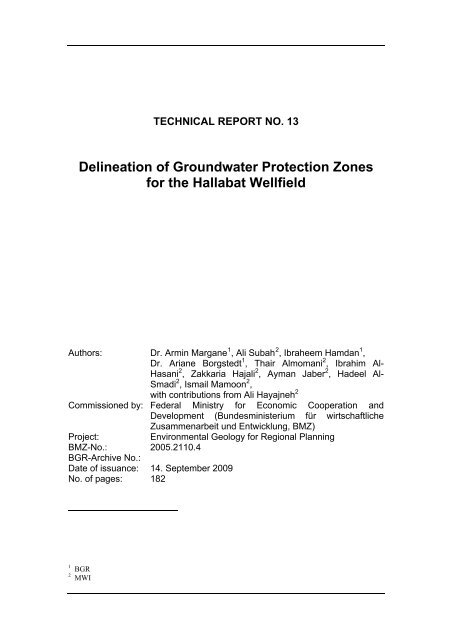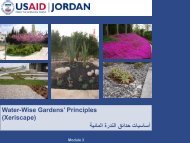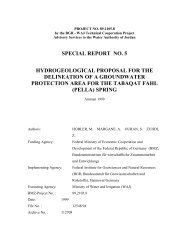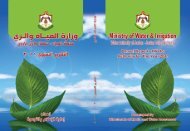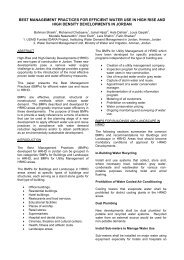Delineation of Groundwater Protection Zones for the Hallabat Wellfield
Delineation of Groundwater Protection Zones for the Hallabat Wellfield
Delineation of Groundwater Protection Zones for the Hallabat Wellfield
Create successful ePaper yourself
Turn your PDF publications into a flip-book with our unique Google optimized e-Paper software.
TECHNICAL REPORT NO. 13<br />
<strong>Delineation</strong> <strong>of</strong> <strong>Groundwater</strong> <strong>Protection</strong> <strong>Zones</strong><br />
<strong>for</strong> <strong>the</strong> <strong>Hallabat</strong> <strong>Wellfield</strong><br />
Authors: Dr. Armin Margane 1 , Ali Subah 2 , Ibraheem Hamdan 1 ,<br />
Dr. Ariane Borgstedt 1 , Thair Almomani 2 , Ibrahim Al-<br />
Hasani 2 , Zakkaria Hajali 2 , Ayman Jaber 2 , Hadeel Al-<br />
Smadi 2 , Ismail Mamoon 2 ,<br />
with contributions from Ali Hayajneh 2<br />
Commissioned by: Federal Ministry <strong>for</strong> Economic Cooperation and<br />
Development (Bundesministerium für wirtschaftliche<br />
Zusammenarbeit und Entwicklung, BMZ)<br />
Project:<br />
Environmental Geology <strong>for</strong> Regional Planning<br />
BMZ-No.: 2005.2110.4<br />
BGR-Archive No.:<br />
Date <strong>of</strong> issuance: 14. September 2009<br />
No. <strong>of</strong> pages: 182<br />
1 BGR<br />
2 MWI
Executive Summary<br />
The <strong>Hallabat</strong> wellfield, located in <strong>the</strong> nor<strong>the</strong>astern part <strong>of</strong> Jordan, about 26 km<br />
east <strong>of</strong> Zarqa, is an important source <strong>for</strong> water supply <strong>of</strong> Amman and Zarqa as<br />
well as <strong>for</strong> <strong>the</strong> local villages. A total <strong>of</strong> 29 wells currently provide 4 MCM/a from<br />
<strong>the</strong> basalt and A7/B2 aquifers.<br />
Because <strong>of</strong> its importance <strong>the</strong> German-Jordanian Technical Cooperation project<br />
“<strong>Groundwater</strong> Resources Management” has chosen this wellfield as one <strong>of</strong> its<br />
working areas <strong>for</strong> <strong>the</strong> delineation <strong>of</strong> groundwater protection zones according to<br />
<strong>the</strong> issued Jordanian "Guidelines <strong>for</strong> Drinking Water Resources <strong>Protection</strong>"<br />
(July 2006). The proposed groundwater protection area has been fur<strong>the</strong>r<br />
subdivided into three zones, which require different degrees <strong>of</strong> landuse<br />
restrictions.<br />
During <strong>the</strong> field work to this report several risks to <strong>the</strong> drinking water supply<br />
provided by <strong>the</strong> <strong>Hallabat</strong> wellfield were identified. They partly arise from deficits<br />
in <strong>the</strong> construction and upkeep <strong>of</strong> <strong>the</strong> water supply infrastructure, from a lack <strong>of</strong><br />
access barriers to <strong>the</strong> protection zone 1 (partly missing fences), from a lack <strong>of</strong><br />
awareness <strong>of</strong> <strong>the</strong> guards (free access to protection zone 1 through open gate)<br />
and from pollution risks in zone 2.<br />
Because some <strong>of</strong> <strong>the</strong> wells have already been affected by bacteriological<br />
contamination, <strong>the</strong> report proposes several corrective measures in order to<br />
reduce <strong>the</strong> contamination risk <strong>of</strong> <strong>the</strong> drinking water source. It is important that<br />
<strong>the</strong>se measures are implemented as soon as possible. Concerning protection<br />
zone 1 WAJ will have to enlarge <strong>the</strong> well perimeter so that <strong>the</strong> distance from <strong>the</strong><br />
well to <strong>the</strong> fence will always be 25 m, as required by <strong>the</strong> guideline. WAJ also<br />
should install an overlapping well cap with a conduit box to avoid direct access<br />
to <strong>the</strong> well, repair <strong>the</strong> damaged pipe network and physically block entrance to<br />
<strong>the</strong> installations. WAJ employs guards <strong>for</strong> groups <strong>of</strong> wells. They usually live<br />
right next to a well from where <strong>the</strong>y take electricity and water. But <strong>the</strong>y also<br />
grow crops, raise animals and dispose <strong>of</strong> <strong>the</strong>ir wastewater in too close vicinity <strong>of</strong><br />
<strong>the</strong> wells. Proper wastewater collection systems should be installed <strong>for</strong> <strong>the</strong>se<br />
guards at a distance <strong>of</strong> not less than 100 m from <strong>the</strong> well. These must be<br />
regularly emptied. Moreover, <strong>the</strong> guards must be taught not to keep <strong>the</strong>ir<br />
animals or grow crops at distances less than 100 m from <strong>the</strong> wells.<br />
A number <strong>of</strong> corrective measures have also been proposed <strong>for</strong> protection zones<br />
2, where <strong>the</strong> most prominent contamination risks arise from agricultural and cow<br />
farming activities. Implementation <strong>of</strong> <strong>the</strong>se measures should be given high<br />
priority. A spreading <strong>of</strong> cow farming, which is currently mainly concentrated<br />
around <strong>the</strong> village Ad Dhuleil, towards <strong>the</strong> <strong>Hallabat</strong> or Corridor wellfields should<br />
be avoided under all circumstances and strongly objected by <strong>the</strong> MWI and WAJ.<br />
In collaboration with <strong>the</strong> Ministry <strong>of</strong> Environment a solution must be found<br />
urgently concerning <strong>the</strong> safe storage and disposal or treatment <strong>of</strong> cow dung. In<br />
<strong>the</strong> focus <strong>of</strong> such a solution should be <strong>the</strong> need <strong>for</strong> protection <strong>of</strong> <strong>the</strong><br />
groundwater resources.<br />
Ano<strong>the</strong>r main threat to <strong>the</strong> drinking water resources is <strong>the</strong> inappropriate storage<br />
and disposal <strong>of</strong> untreated wastewater. There is currently no public wastewater<br />
collection and treatment system in <strong>the</strong> area. It is recommended that WAJ
installs a wastewater collection and treatment system <strong>for</strong> <strong>the</strong> village <strong>of</strong> Ad<br />
Dhuleil, which is growing fast and where <strong>the</strong>re are already numerous industrial<br />
sites. Awareness raising which should bring about behavioral change within <strong>the</strong><br />
population is crucial with regards to wastewater collection and treatment and<br />
<strong>the</strong> BGR-MWI project supports activities in this regard.<br />
Since <strong>the</strong> implementing agency concerning groundwater protection zones 2 is<br />
<strong>the</strong> Ministry <strong>of</strong> Environment, <strong>the</strong> responsible staff will need to control <strong>the</strong><br />
en<strong>for</strong>cement <strong>of</strong> <strong>the</strong> proposed measures.<br />
In order to avoid fur<strong>the</strong>r contamination risks in <strong>the</strong> future, it is seen as important<br />
that <strong>the</strong> landuse planning authorities closely coordinate <strong>the</strong>ir activities with <strong>the</strong><br />
Ministry <strong>of</strong> Water and Irrigation as well as with <strong>the</strong> Water Authority <strong>of</strong> Jordan.<br />
The project will carry out workshops <strong>for</strong> awareness building and provide training<br />
<strong>for</strong> <strong>the</strong> implementation agencies.<br />
<strong>Protection</strong> zone 3 encloses <strong>the</strong> entire groundwater contribution zone <strong>of</strong> <strong>the</strong><br />
wellfield. Environmental sound practices <strong>for</strong> all activities have to be<br />
implemented.<br />
Due to <strong>the</strong> numerous potential hazards to groundwater and uncontrolled<br />
expansion <strong>of</strong> agriculture and animal farming, groundwater abstraction in <strong>the</strong><br />
<strong>Hallabat</strong> area bears many risks. Targets and objectives <strong>of</strong> abstraction and<br />
protection are much easier to be maintained <strong>for</strong> <strong>the</strong> Corridor wellfield compared<br />
to <strong>the</strong> <strong>Hallabat</strong> wellfield. If, however, <strong>the</strong> decision is taken to maintain<br />
abstraction at <strong>Hallabat</strong> in <strong>the</strong> long-term, a new concept <strong>for</strong> abstraction needs to<br />
be prepared, which includes all required measures <strong>for</strong> groundwater protection.<br />
Over <strong>the</strong> past 10 years a constant decrease in yield in <strong>the</strong> Western <strong>Hallabat</strong><br />
wellfield had been noticed. This is caused by <strong>the</strong> declining groundwater levels<br />
and thus <strong>the</strong> decreasing saturation thickness <strong>of</strong> <strong>the</strong> aquifer. The overall<br />
saturated thickness, and in particular <strong>the</strong> saturated thickness <strong>of</strong> <strong>the</strong> basalt,<br />
which provides <strong>the</strong> major share <strong>of</strong> groundwater <strong>for</strong> <strong>the</strong> water supply, is much<br />
higher in <strong>the</strong> Eastern <strong>Hallabat</strong> wellfield than in <strong>the</strong> Western wellfield. There<strong>for</strong>e<br />
exploitation should focus on <strong>the</strong> eastern wellfield and exploitation in <strong>the</strong> western<br />
wellfield should be abandoned in <strong>the</strong> long-term. It will <strong>the</strong>n be necessary to<br />
extend <strong>the</strong> Eastern <strong>Hallabat</strong> wellfield and drill more wells towards <strong>the</strong> north and<br />
east <strong>of</strong> <strong>the</strong> current wells. In order to protect <strong>the</strong>se future extension areas<br />
already now, it must be ensured that potentially hazardous activities, such as<br />
agriculture or cow farming, do not spread to <strong>the</strong>se areas. Also <strong>the</strong> basalt quarry,<br />
which was established recently to <strong>the</strong> north <strong>of</strong> <strong>the</strong> East <strong>Hallabat</strong> wellfield<br />
constitutes a major threat <strong>for</strong> any possible future extension <strong>the</strong>re<strong>of</strong>, especially<br />
<strong>the</strong> hydrocarbons used <strong>for</strong> <strong>the</strong> operation <strong>of</strong> <strong>the</strong> site and maintenance <strong>of</strong> <strong>the</strong><br />
vehicles.


